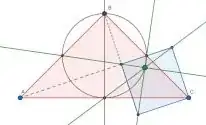I was trying to get a feel for how to solve another question about the largest triangle that can fit in a unit square, by constructing the smallest enclosing square of a triangle in Geogebra. While doing this I 'discovered' what appears to be a new point on the nine-point circle of a triangle, that relates a rectangle to a triangle via a circle.
Here the intersection with the nine-point-circle is outside both the rectangle and the triangle.
The intersection in this case, is the only point on the nine-point-circle that is entirely within the triangle.
If the triangle is a right triangle and the rectangle is constructed so that side of the rectangle lies on the midpoint between the shared vertex and the right angle, the rectangle is a square.
The point is very easy to construct. Construct a rectangle such that each of the (possibly extended) sides lies on a vertex of the triangle. Since there are 4 vertices on the rectangle and only 3 on the triangle, the rectangle and triangle must always have a vertex in common. Now draw lines from each of the unshared vertices of the rectangle to the midpoint of the associated side of the triangle. These 3 lines will always intersect at a point that lies on the nine-point-circle of the triangle, although I cannot prove that formally.
This remains true even if the rectangle overlaps the triangle or is smaller that the triangle.
I think this point is interesting because it shows how a triangle and a rectangle and a circle are related, and I have never seen a triangle centre or point on a nine-point-circle constructed like this before.
Here is a link to an interactive construction uploaded to the Geogebra website. Any of the blue points on the construction can be moved.
I cannot relate this point to any other well know centre or line of a triangle. At the moment the point can only be found by constructing the rectangle first. If it was possible to construct the point independently, it could be helpful in constructing the smallest possible enclosing square of a given triangle and help answer the question posed by the other member.
Wondering if this is a new point I found an online Encyclopaedia of Triangles but have no idea how to search that database. Is it new? Has anyone seen it before and does it have a name?





